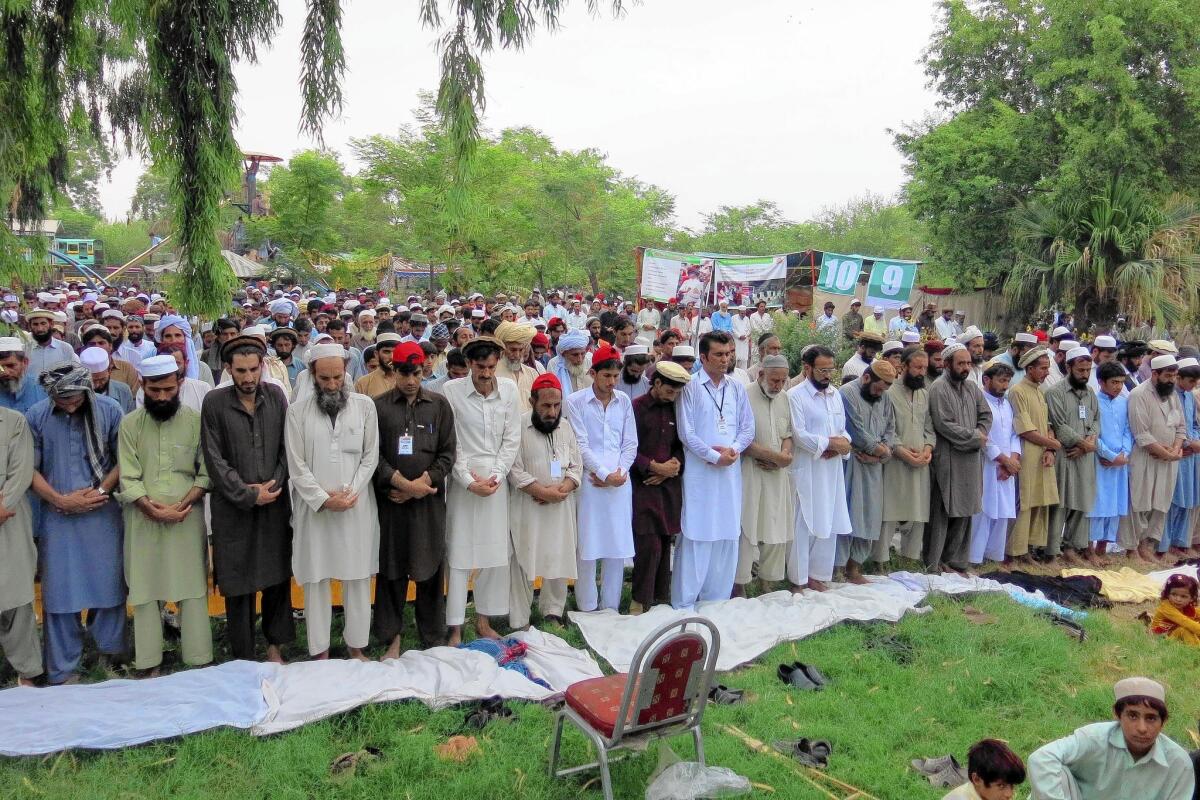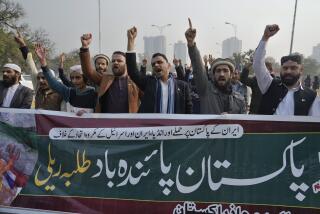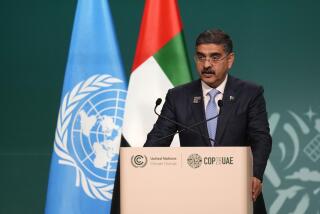Pakistan offensive disrupting militant attacks, U.S. says

- Share via
Reporting from Islamabad, Pakistan — A six-week Pakistani army offensive has succeeded in disrupting the militant groups that have long enjoyed free rein in the rugged North Waziristan tribal region along the border with Afghanistan, Obama administration officials say.
But proof of the operation’s success, they say, will be whether groups such as the notorious Haqqani network are allowed to reconstitute themselves in North Waziristan or elsewhere and again plot attacks against U.S.-led forces in neighboring Afghanistan or elsewhere.
Previous Pakistani offensives in the tribal belt have either ignored groups like the Haqqanis — who are blamed for deadly attacks against U.S.-led forces in Afghanistan — or allowed them to return. U.S. military officials believe that top levels of Pakistan’s security establishment back the Haqqanis as a proxy force to maintain influence in Afghanistan.
But with most U.S. forces withdrawing from Afghanistan at the end of the year, the U.S. military’s ability to battle the Haqqani network is expected to diminish sharply. Obama administration officials have pressed Pakistan’s military leaders in a series of meetings this month to ensure the group does not escape the current operation.
“We keep telling them they must go after all the terrorists and that they cannot cherry-pick,” said a senior U.S. official who requested anonymity to discuss the sensitive talks. “We’ve been quite emphatic about that.”
Pakistan insists that no insurgent groups will be spared in the offensive, which began in mid-June and has resulted in the deaths of more than 500 militants and the seizure of large weapons caches and bomb-making factories, according to unconfirmed Pakistani army reports.
But some officials say that insurgents fled the area before the start of the offensive, which had been rumored for several months.
U.S. officials have not received photographs or other visual evidence from Pakistan showing it has directly targeted the Haqqani network. In the end, the senior U.S. official said, “We end up having a good conversation but the bottom line is we have to be convinced there is no reconstituting of terrorist facilities and safe havens.”
Some analysts believe that Pakistan is taking action now because of a provision in the 2015 Pentagon budget that could withhold hundreds of millions of dollars in counter-terrorism funding unless Defense Secretary Chuck Hagel certifies that Pakistan has “significantly disrupted the safe haven and freedom of movement of the Haqqani network.”
Now that they have begun such an operation, “the Pakistanis are making an argument in Washington that they should be given continued coalition support,” C. Christine Fair, author of “Fighting to the End: The Pakistan Army’s Way of War,” told the Times of India in an interview this week. Pakistan has received $28 billion in U.S. military and economic aid since 2002, and additional expenditures would be “outrageous,” she said.
Pakistan has not given a timetable for the offensive, which began with airstrikes and has proceeded to ground operations in Miram Shah and Mir Ali, the largest towns in North Waziristan, which are now mostly controlled by the military.
Pakistani officials declined to comment specifically on the Haqqani network, which analysts regard as one of the most experienced insurgent groups fighting in Afghanistan. The group, led by Sirajuddin Haqqani, is under the umbrella of the Afghan Taliban but is seen as being more closely linked to Al Qaeda’s central leadership.
U.S. military leaders have long believed that Pakistan did not target the Haqqani network before because it does not carry out attacks in Pakistan. Afghan authorities also accuse Pakistan of sparing the Haqqani network in the current offensive, arguing that no senior commander in the group has been reported killed.
Last week, a spokesman for the Afghan intelligence service, the National Directorate of Security, alleged that Pakistan’s security establishment had shifted Haqqani fighters to safe places before the operation began, prompting swift denials from Pakistani officials.
At a news conference the next day, Pakistan Foreign Secretary Aizaz Ahmad Chaudhry said Afghanistan, whose army is struggling to contain a domestic Taliban insurgency, should take action against militants fleeing over the border from Pakistan.
“It is … our expectation that action would be taken on the Afghan side to check the fleeing terrorists and not to allow Afghan territory to be used by anti-Pakistan elements,” Chaudhry said.
Tribal leaders who spoke on condition of anonymity because they feared reprisals from the militants have said the Haqqanis and other groups fled North Waziristan in the days before the operation began. With less than one-third of the tribal region reportedly under government control, many fighters are believed to have taken refuge in other areas of North Waziristan, including Datta Khel, the site of recent U.S. drone strikes, and in the thickly forested Shawal valley.
Rahimullah Yusufzai, a Pakistani journalist who closely follows militant groups, said the current operation has displaced the Haqqani network but the insurgents, who typically operate in groups of about 20, would eventually be able to regroup and plot attacks in Afghanistan from elsewhere in the area.
“It would take some time for them to establish their training and communication facilities at some other place,” he said, and targeting Afghan border provinces such as Khowst and Paktika soon “would not be a problem for them.”
Special correspondent Sahi reported from Islamabad and Times staff writer Bengali from Mumbai, India.
More to Read
Sign up for Essential California
The most important California stories and recommendations in your inbox every morning.
You may occasionally receive promotional content from the Los Angeles Times.











